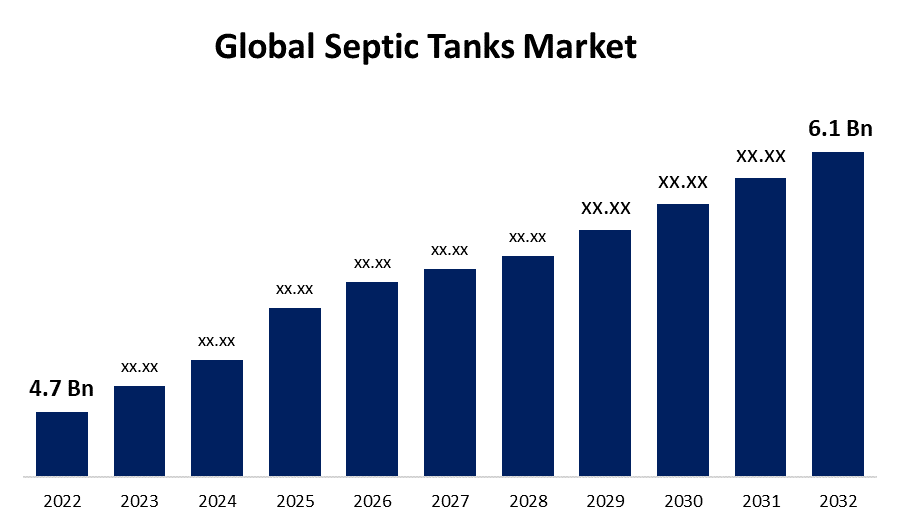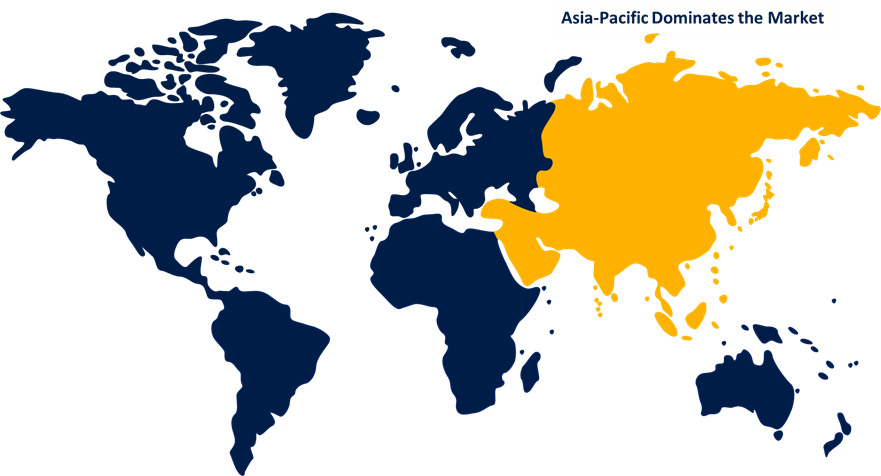Global Septic Tanks Market Size, Share, and COVID-19 Impact By Material (Plastic, Fiberglass And Concrete), By Application (Residential, Commercial, and Industrial), by Region (North America, Europe, Asia-Pacific, Latin America, Middle East, and Africa), Analysis and Forecast 2022 – 2032.
Industry: Chemicals & MaterialsGlobal Septic Tanks Market Insights Forecasts to 2032
- The Septic Tanks Market Size was valued at USD 4.7 Billion in 2022.
- The Market Size is Growing at a CAGR of 4.6% from 2022 to 2032
- The Worldwide Septic Tanks Market Size is expected to reach USD 6.1 Billion by 2032
- North America is expected To Grow the fastest during the forecast period.

Get more details on this report -
The Global Septic Tanks Market Size is expected to reach USD 6.1 Billion by 2032, at a CAGR of 4.6% during the forecast period 2022 to 2032.
A septic tank is a sizable, underground wastewater treatment device that is frequently utilised in suburban and rural regions without access to centralised sewage systems. Its functions include gathering, storing, and treating domestic wastewater from sinks, showers, toilets, and other plumbing fixtures. The septic tank itself, a watertight container commonly composed of concrete, fibreglass, or plastic, is the fundamental component of the system. It receives all of the wastewater from the residence and is buried underneath. Regular maintenance is necessary for septic tank systems to operate correctly. To get rid of accumulated sediments and stop them from entering the drainfield, where they can cause clogs and system failure, regular tank pumping is necessary.
Impact of COVID-19 on the Global Septic Tanks Market
Due to safety worries and movement limitations in the early phases of the pandemic and lockdowns, numerous construction projects were postponed or stopped entirely. This might have caused a short pause in projects or new septic tank installations. Reduced home sales and property transactions during times of economic instability also had an impact on the real estate market. The need for new septic tank installations may have consequently lessened. To boost economies during the pandemic, many countries announced stimulus plans and infrastructure investments. Some of these actions might have included support for sewage infrastructure and wastewater management, which might have benefited the septic tank business. Due to the pandemic, interest in suburban and rural living surged as remote work and lifestyle preferences altered. In places without centralised sewage systems, this development might have increased demand for septic tank installations. The septic tank market may have encountered difficulties because of supply chain interruptions, a lack of materials, and rising prices, just like many other businesses.
Global Septic Tanks Market Report Coverage
| Report Coverage | Details |
|---|---|
| Base Year: | 2022 |
| Market Size in 2022: | USD 4.7 Billion |
| Forecast Period: | 2022-2032 |
| Forecast Period CAGR 2022-2032 : | 4.6% |
| 2032 Value Projection: | USD 6.1 Billion |
| Historical Data for: | 2018-2021 |
| No. of Pages: | 200 |
| Tables, Charts & Figures: | 110 |
| Segments covered: | By Material, By Application, by Region, |
| Companies covered:: | Orenco Systems, Inc., Rewatec, Conder Sewage technology Ltd, Asio, Simop, JoJo, Klargester Environmental, WPL Ltd, Chem-Tainer Industries, Zehnder Pumpen GmbH, Danmotech Ltd., Biorock, Inc., Saint Dizier Environnement, Techneau, Eurobeton, Graf UK Ltd., and Bluetec |
| Pitfalls & Challenges: | COVID-19 Empact, Challenge, Future, Growth, & Analysis |
Get more details on this report -
Key Market Drivers
The need for housing and infrastructure, including sewage treatment systems like septic tanks, was driven by the expanding world population and the quick urbanisation of developing nations. Centralised sewage systems were either unavailable or not practical economically in many rural and semi-urban areas. The use of a septic tank to store wastewater is a common practise, however it is also possible to use a septic tank. The COVID-19 epidemic accelerated a tendency towards suburbanization and rural living, which raised demand in places lacking centralised sewage infrastructure. This increased demand for the installation of septic tanks in certain areas. Technology improvements in the septic tank sector led to the creation of more effective and environmentally friendly septic systems. These developments made the market more appealing and promoted adoption. Demand for effective wastewater treatment options like septic tanks has increased as a result of growing awareness of water contamination and its effects on public health and the environment. The demand for septic tanks was impacted by the expansion of the worldwide real estate and construction industries, particularly in new residential and commercial building.
Key Market Challenges
Transporting and installing septic tanks can be difficult and expensive in areas with little infrastructure or difficult access, which may prevent their broad adoption. Regular maintenance and frequent pumping are necessary for septic tanks to remove accumulated sediments. Some users might disregard upkeep, which would result in system failures, pollution of the environment, and expensive repairs. Excavation, materials, and labour costs must all be paid up front for the installation of a septic tank system. Some homes or companies may find this upfront expenditure to be prohibitive. Excavation, supplies, and labour costs all need to be paid upfront in order to establish a septic tank system. For some business owners or homeowners, this upfront expense may be prohibitive. The market share of septic tanks is impacted by competition from other wastewater treatment technologies such decentralised treatment facilities, composting toilets, and aerobic treatment units.
Market Segmentation
Material Insights
Concrete segment is dominating the market over the forecast period
On the basis of material, the global septic tanks market is segmented into Plastic, Fiberglass, Concrete, and Others. Among these, the concrete segment is dominating the market with the largest market share over the forecast period. The strength and lifespan of concrete septic tanks are well recognised. In comparison to other materials, they are less prone to damage because of their capacity to endure external forces. Concrete is a material that is readily available, and multiple businesses from various locations produce septic tanks made of concrete, which helps the market for these products grow. Concrete septic tanks have long been a popular option for on-site wastewater treatment in suburban and rural regions without access to centralised sewage networks.
Application Insights
Residential segment accounted the largest market share over the forecast period
Based on the application, the global septic tanks market is segmented into Residential, Commercial, and Industrial. Among these, the residential segment accounted the largest market share over the forecast period. Septic tank systems provide a more decentralised and environmentally friendly method of wastewater treatment, and as people become more aware of their environmental impact, some homes may decide to utilise them. Individual on-site wastewater treatment systems, such as septic tanks, are preferred by residential homeowners in some areas because they give them more control over their wastewater disposal than centralised sewer systems do. As the world's population continues to increase, new neighbourhoods are being built in addition to existing ones being expanded. As a result, additional septic tank systems are required to manage home wastewater.
Regional Insights
Asia Pacific region accounts the largest market share over the forecast period

Get more details on this report -
Among all other regions, the Asia Pacific region accounts the largest market share over the forecast period. Significant population increase has been occurring in the Asia-Pacific area, especially in nations like India, China, and Indonesia. The need for housing and infrastructure, including septic tank systems, has expanded as a result of this demographic boom. Despite the fact that urbanisation is spreading throughout the region, many rural regions still have sporadic access to centralised sewage systems. The use of a septic tank is a common practise in the United States. Interest in suburban and rural living has grown as economies mature and lifestyles change. The demand for septic tanks is growing as a result of the growing number of people who are using them as a source of income, and the availability of a variety of services. The effectiveness and dependability of septic tank systems on the market have grown due to developments in septic tank technology, including better designs and materials.
North America is witnessing the fastest market share over the forecast period. There are many suburban and rural communities in North America without centralised sewer systems. As a result, the use of septic tanks as a source of water for residential homes has become increasingly common. The need for septic tanks is driven by the expansion of the housing and real estate sectors in North America, particularly in new residential projects where centralised sewer connections might not be practical.
Recent Market Developments
- On February 2022, in order to purchase the Ondura Group, Kingspan has entered into an exclusive put option agreement.
List of Key Companies
- Orenco Systems, Inc.
- Rewatec
- Conder Sewage technology Ltd
- Asio
- Simop
- JoJo
- Klargester Environmental
- WPL Ltd
- Chem-Tainer Industries
- Zehnder Pumpen GmbH
- Danmotech Ltd.
- Biorock, Inc.
- Saint Dizier Environnement
- Techneau
- Eurobeton
- Graf UK Ltd.
- Bluetec
Market Segment
This study forecasts revenue at global, regional, and country levels from 2019 to 2032. Spherical Insights has segmented the global Septic Tanks Market based on the below-mentioned segments:
Septic Tanks Market, Material Analysis
- Plastic
- Fiberglass
- Concrete
- Others
Septic Tanks Market, Application Analysis
- Residential
- Commercial
- Industrial
Septic Tanks Market, Regional Analysis
- North America
- US
- Canada
- Mexico
- Europe
- Germany
- Uk
- France
- Italy
- Spain
- Russia
- Rest of Europe
- Asia Pacific
- China
- Japan
- India
- South Korea
- Australia
- Rest of Asia Pacific
- South America
- Brazil
- Argentina
- Rest of South America
- Middle East & Africa
- UAE
- Saudi Arabia
- Qatar
- South Africa
- Rest of Middle East & Africa
Need help to buy this report?